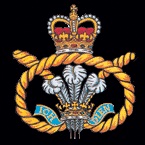| Staffordshire Regiment (The Prince of Wales's) | |
|---|---|
 Cap badge | |
| Active | 1959–2007 |
| Disbanded | 2007 |
| Country | |
| Branch | |
| Type | Infantry |
| Role | Armoured Infantry |
| Size | One Battalion |
| Part of | Prince of Wales's Division |
| Nickname | The Staffords |
| Colors | Black & Gold |
| March | Quick – The Staffordshire Regiment Slow – God Bless the Prince of Wales |
| Mascots | Staffordshire Bull Terrier, each successive mascot called Watchman |
| Anniversaries | Anzio (22 January), Ypres (31 July), Arnhem (17 September), Ferozeshah (21 December) |
| Commanders | |
| Colonel in Chief | Prince Andrew, Duke of York |
| Colonel of the Regiment | Brigadier James Kenneth Tanner OBE |
| Insignia | |
| Tactical Recognition Flash |  |
| Arm Badge | Glider From South Staffordshire Regiment |
The Staffordshire Regiment (Prince of Wales's) (or simply "Staffords" for short) was an infantry regiment of the British Army, part of the Prince of Wales's Division. The regiment was formed in 1959 by the amalgamation of the South Staffordshire Regiment and the North Staffordshire Regiment (Prince of Wales's), and in 2007 was amalgamated with the Cheshire Regiment and the Worcestershire and Sherwood Foresters Regiment to become the 3rd Battalion, Mercian Regiment.
Contents
- History
- Formation
- Northern Ireland
- Gulf War
- Iraq War
- Amalgamation
- Structure
- Regimental museum
- Battle honours
- Regimental Colonels
- Alliances
- References
- External links
In 2014, the 3rd Battalion, Mercian Regiment was merged with the 1st and 2nd battalions, to create the 1st and 2nd battalions, Mercian Regiment (Cheshires, Worcesters and Sherwood Foresters, and Staffords).
The mascot of the Staffordshire Regiment was a Staffordshire Bull Terrier; each successive mascot took the name Watchman. The current serving mascot is known as Private Watchman VI and he carries out his duties as part of the Staffordshire Regimental Association.

